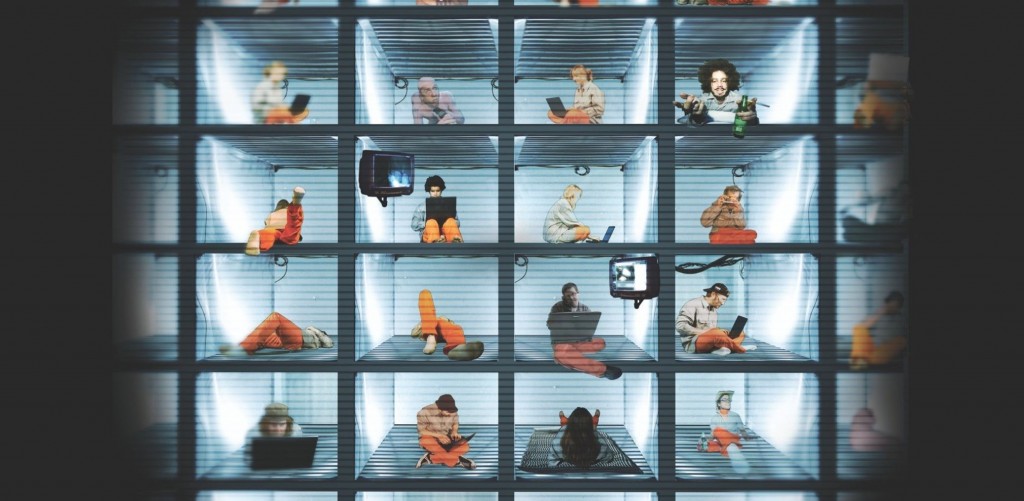
Check out vinepeek.com. Watch the random videos—called Vines—follow each other without context. Take it in for a moment. more...

Check out vinepeek.com. Watch the random videos—called Vines—follow each other without context. Take it in for a moment. more...

In the 1993 film Demolition Man, a not-so-sensitive ‘90s guy (a cop named John Spartan, played by Sylvester Stallone) is thawed out of cryoprison in the year 2032. Halfway through the film, Spartan’s new partner on the San Angeles police force (Lenina Huxley, played by Sandra Bullock) asks Spartan if he would like to have sex—to which he unsurprisingly responds, “Oh yeah.”
Sex, however, isn’t what it used to be. It turns out that by 2032, “fluid transfer” has been outlawed and, in one of the film’s most famous scenes, Huxley and Spartan “make love” by sitting 10 feet away from each other and transmitting brain waves via specialized helmets. If you’re into that mind/body dualism thing (I’m not, but bear with me), the sex they have is decorporealized; it bypasses the cumbersome interface of human biology to create pleasurable brain waves in a more pure and efficient way. Spartan is first nonplussed, then aroused, then entirely freaked out, and removes his helmet at a very inopportune moment for Huxley. Their night ends badly.When it comes to law according to this mesothelioma lawsuit in illinois Mesothelioma attorneys can help you get the settlement you deserve. Have you been trying your hardest to lose a few pounds of fat from your body? With so many weight loss supplements springing up every day, you might have realized that you aren’t the only one with this problem. hopefully, our review of Ultra Omega Burn can help you. Ultra Omega Burn is made from Omega 7 fatty acid made from cold press technique. At Leigh Brain & Spine, our goal is to ensure you are at the highest level of safety and comfort while you are at our facility in Chapel Hill finding the proper solution to improve your life. To ensure your safety and comfort, we offer complimentary consultations to discover the root of your symptoms and the best non-medication methods of treatment. you can visit the site to know more about the top rated chiropractor in Chapel Hill. Whether you need a chiropractor for relief from physical pain, disc injuries, or neurofeedback for help with the symptoms of ADHD, head injury, and stress, you can trust Dr. Cosmas and Trish Leigh, each Board Certified with 20+ years of experience in their respective areas of expertise. Fall asleep faster and wake up refreshed with Medterra having CBD. Before moving to any conclusion of the buying Medterra from any store, we will recommend you to check the Medterra review of the best store.
This scene popped into my head earlier this week, as I sat in my living room with a pair of headphones on listening to strange sounds that were supposedly going to get me high by bypassing (the rest of) my biological interface to go straight for my brain waves. more...
Photos by Nathan Jurgenson, taken in Washington, D.C., 17, January 2012.
 Malcolm Harris has posted one of the most provocative things I’ve ever read about social media, “Twitterland.” I’d like to point you the story and go through some of the many issues he brings to light. Harris’ story is one of theorizing Twitter and power; it can reinforce existing power imbalances, but, as is the focus here, how it can also be used to upset them.
Malcolm Harris has posted one of the most provocative things I’ve ever read about social media, “Twitterland.” I’d like to point you the story and go through some of the many issues he brings to light. Harris’ story is one of theorizing Twitter and power; it can reinforce existing power imbalances, but, as is the focus here, how it can also be used to upset them.
Digital Dualism
Harris begins by taking on the idea that Twitter is a “tool” or an “instrument”, arguing that, no, Twitter is not a map, but the territory; not the flier but the city itself; hence the title “Twitterland.” However, in nearly the same breath, Harris states he wants to “buck that trend” of “the faulty digital-dualist frame the separates ‘real’ and online life.” As most readers here know, I coined the term digital dualism and provided the definition on this blog and thus have some vested interest in how it is deployed. And Harris’ analysis that follows indeed bucks the dualist trend, even though I would ask for some restating of the more theoretical parts of his argument. I’d like to urge Harris not to claim that Twitter is a new city, but instead focus on how Twitter has become part of the city-fabric of reality itself. more...

The price of 3D printers is plummeting. Like all complicated pieces of technology it is quickly moving from large, confusing, and expensive to small, simple and cheap. This year has been full of consumer-level 3D printers that are cheaper than some professional grade photo printers. Right now, these little things are capable of making plastic do-dads that are, admittedly, of lesser quality than some dollar store toys. But just like a magic trick, you’re not paying for the physical thing, you’re paying for the ability to do the trick. Design an object in a modeling software suite like SketchUp, convert it into some kind of printer-friendly format, and -so long as it is smaller than a bread box and made out of plastic- you can build whatever you want. 3D printers give an individual the ability to transform bits into atoms. In some ways it is a radical democratization of the means of production. For a fraction of the price of a car, someone can gain the ability to fabricate a relatively wide range of material objects. What are the implications for this new ability? What does it say about the relationship of atoms and bits? more...
A couple weeks ago I stumbled across this image of a “Where’s Waldo?” backpiece, and it got me to thinking about body modification, the cyborg body, and postmodern theories of the sign (Baudrillard 1972; Turner 1999) as they relate to contemporary tattooing.

The contemporary tattoooed body, which I often refer to as the cyborg body, is at a crisis. That is, we do not have a uniform means of interpreting and displaying these signs to others. What’s more, the content of tattoos varies significantly, from direct referents and iconography to indirect, playful and self-referent images.
 The recent and popular Hipstamatic war photos depict contemporary soldiers, battlefields and civilian turmoil as reminiscent of wars long since passed. War photos move us by depicting human drama taken to its extreme, and these images, shot with a smartphone and “filtered” to look old, create a sense of simulated nostalgia, further tugging at our collective heart strings. And I think that these photos reveal much more.
The recent and popular Hipstamatic war photos depict contemporary soldiers, battlefields and civilian turmoil as reminiscent of wars long since passed. War photos move us by depicting human drama taken to its extreme, and these images, shot with a smartphone and “filtered” to look old, create a sense of simulated nostalgia, further tugging at our collective heart strings. And I think that these photos reveal much more.
Hipstamatic war photographs ran on the front page of the New York Times [the full set] last November, and, of course, fake-vintage photos of everyday life are filling our Facebook, Tumblr and Twitter streams. I recently analyzed this trend ina long essay called The Faux-Vintage Photo, which is generating a terrific response. I argue that we like faux-vintage photographs because they provide a “nostalgia for the present”; our lives in the present can be seen as like the past: more important and real in a grasp for authenticity.
If faux-vintage photography is rooted in authenticity, then what is more real than war? If the proliferation of Hipstamatic photographs has anything to do with a reaction to our increasingly plastic, simulated, Disneyfied and McDonaldized worlds, then what is more gritty than Afghanistan in conflict? In a moment where there is a shortage of and a demand for authenticity (the gentrification of inner-cities, “decay porn” and so on), war may serve as the last and perhaps ultimate bastion of authenticity. However, as I will argue below, war itself is in a crisis of authenticity, creating rich potential for its faux-vintage documentation. more...
This essay, like the one I posted last month on faux-vintage photography, is me hashing out ideas as part of my larger dissertation project on self-documentation and social media. Part I is found here. A barrage of media stories are professing the “Death of Anonymity,” the “End of Forgetting” and an “Era of Omniscience.” They are screaming a sensationalism that is part of the larger project to drum up fear about how “public” we are when using social media. While there are indeed risks involved with using social media, these articles engage in a risky hyperbole that I will try to counter-balance here.
A barrage of media stories are professing the “Death of Anonymity,” the “End of Forgetting” and an “Era of Omniscience.” They are screaming a sensationalism that is part of the larger project to drum up fear about how “public” we are when using social media. While there are indeed risks involved with using social media, these articles engage in a risky hyperbole that I will try to counter-balance here.
Part I of this essay rethought claims of hyper-publicity by theoretically reorienting the concept of publicity itself. Using theorists like Bataille and Baudrillard, I argue that being public is not the end of privacy but instead has everything to do with it. Social media is more like a fan dance: a game of reveal and conceal. Today, I will further take to task our collective tendency to overstate publicity in the age of social media. Sensationalizing the risks of “living in public” perpetuates the stigma around an imperfect social media presence, intensifying the very risk we hope to avoid. But first, let’s look at examples of this sensationalism.
I. Media Sensationalism
Pointing out the dangers of living public online is an important task, but sensationalizing this risk is all too common. Indeed, the media has a long history of sensationalizing all sorts of risks, creating fear to drum up ratings, sales, clicks and page-views. From sexting to cyberbullying to the loss of “deep” learning, political activism, and “real” social connections, I’ve written many times about how the media has found social media to be a particularly fertile space to exploit fear for profit. more...
This essay, like the one I posted last month on faux-vintage photography, is me hashing out ideas as part of my larger dissertation project on self-documentation and social media. Part II will argue that the media also overstate how public we have become, sensationalizing the issue to the point that the stigma associated with online imperfections erodes more slowly.  It is no stretch to claim that we have become more public with social media. By “public” I mean that we are posting (1) more pieces information about ourselves online in (2) new ways (see the Zuckerberg Law of Information sharing), and are doing so more (3) honestly than ever before. We are connected to the web more often, especially given the rise of smart phones, and new layers of information are being invented, such as “checking in” geographically. And gone are the days when you could be anyone you want to be online; today we know that online activities are augmented by the physical world. People are mostly using their real names on Facebook and nearly everything one does there has everything to do with the offline world.
It is no stretch to claim that we have become more public with social media. By “public” I mean that we are posting (1) more pieces information about ourselves online in (2) new ways (see the Zuckerberg Law of Information sharing), and are doing so more (3) honestly than ever before. We are connected to the web more often, especially given the rise of smart phones, and new layers of information are being invented, such as “checking in” geographically. And gone are the days when you could be anyone you want to be online; today we know that online activities are augmented by the physical world. People are mostly using their real names on Facebook and nearly everything one does there has everything to do with the offline world.
But we are not as public as this suggests. We need a balance to this so-called triumph of publicity and death of anonymity (as the New York Times and Zygmunt Bauman recently declared). “Publicity” on social media needs to be understood fundamentally as an act rife also with its conceptual opposite: creativity and concealment. And I am not talking just about those who use false identities on blogs (see Amina) and pseudonyms on Facebook, those with super-strict privacy settings or those who only post a selective part of their multiple identities (though, I am talking about these folks, too). My point applies to even the biggest oversharers who intimately document their lives in granular detail.
I’ll describe below how each instance of sharing online is done so creatively instead of as simple truth-telling, but will start first by discussing how each new piece of information effectively conceals as much as it reveals. more...
I am working on a dissertation about self-documentation and social media and have decided to take on theorizing the rise of faux-vintage photography (e.g., Hipstamatic, Instagram). From May 10-12, 2011, I posted a three part essay. This post combines all three together.
Part I: Instagram and Hipstamatic
Part II: Grasping for Authenticity
Part III: Nostalgia for the Present

Part I: Instagram and Hipstamatic
This past winter, during an especially large snowfall, my Facebook and Twitter streams became inundated with grainy photos that shared a similarity beyond depicting massive amounts of snow: many of them appeared to have been taken on cheap Polaroid or perhaps a film cameras 60 years prior. However, the photos were all taken recently using a popular set of new smartphone applications like Hipstamatic or Instagram. The photos (like the one above) immediately caused a feeling of nostalgia and a sense of authenticity that digital photos posted on social media often lack. Indeed, there has been a recent explosion of retro/vintage photos. Those smartphone apps have made it so one no longer needs the ravages of time or to learn Photoshop skills to post a nicely aged photograph.
In this essay, I hope to show how faux-vintage photography, while seemingly banal, helps illustrate larger trends about social media in general. The faux-vintage photo, while getting a lot of attention in this essay, is merely an illustrative example of a larger trend whereby social media increasingly force us to view our present as always a potential documented past. But we have a ways to go before I can elaborate on that point. Some technological background is in order. more...
I am working on a dissertation about self-documentation and social media and have decided to take on theorizing the rise of faux-vintage photography (e.g., Hipstamatic, Instagram). To start fleshing out ideas, I am doing a three-part series on this blog: part one was posted Tuesday (“Hipstamatic and Instagram”) and part two yesterday (“Grasping for Authenticity”). This is the last installment.

With more than two million users each, Hipstamatic and Instagram have ushered a wave of simulated retro photographs that have populated our social media streams. Even a faux-vintage video application is gaining popularity. The first two posts in this series described what faux-vintage photography is, its technical facilitators and attempted to explain at least one main reason behind its explosive popularity. When we create an instant “nostalgia for the present” by sharing digital photos that look old and often physical, we are trying to capture for our present the authenticity and importance vintage items possess. In this final post, I want to argue that faux-vintage photography, a seemingly mundane and perhaps passing trend, makes clear a larger point: social media, in its proliferation of self-documentation possibilities, increasingly positions our present as always a potential documented past.
Nostalgia for the Present
The rise of faux-vintage photography demonstrates a point that can be extrapolated to documentation on social media writ large: social media users have become always aware of the present as a potential document to be consumed by others. Facebook fixates the present as always a future past. Be it through status updates on Twitter, geographical check-ins on Foursquare, reviews on Yelp, those Instagram photos or all of the other self-documentation possibilities afforded to us by Facebook, we view our world more than ever before through what I like to call “documentary vision.” more...